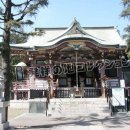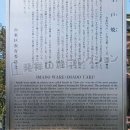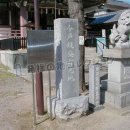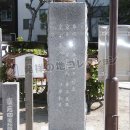今戸焼 発祥之地
いまどやきはっしょうのち
浅草は浅草寺の 約1km北東, 待乳山聖天の 300m北にある 今戸神社。 この拝殿前に 白い石碑が建っていて, 台東区教育委員会の説明板が添えられている。
徳川時代末期に 江戸で消費される陶磁器の半数は 瀬戸焼と美濃焼で, その他 伊万里焼, 信楽焼, 常滑焼, 備前焼 など 地方で生産されるものが大半を占めていた。しかし 一部には 墨田川焼・玉川焼・渋谷焼など江戸産の焼物も 使用されており, 中でも 多く使用されていたのが「今戸焼」である。
今戸焼は, 隅田川のほとりで 瓦を焼いたのが始まりで, 合間に 七厘・火鉢 などの生活雑器のような 庶民の生活に密着した製品を作っていた。その一つの形態が「今戸人形」で, 力士・福助・狐・馬などの人形が作られた。 特に 招き猫が有名で, 「今戸焼」と呼ばれて 親しまれた。
近代以降は, 浅草周辺の市街地化が進み, 粘土がとれなくなったため 職人がこの地を離れ, 太平洋戦争後は ただ一軒の窯元のみが残って 制作を続けている。今戸神社の社務所内には, 招き猫を中心に 各種の今戸焼が陳列されている。 飾り気のない 素朴な形の招き猫が 今戸焼の特徴だそうである。
写真
碑文
今戸焼発祥之地
平成11年3月吉日 建立
窯元 近江屋製陶所 井上歳正
窯元善入 白井和夫
今戸焼 台東区今戸一丁目五番二十二号 今戸神社
今戸焼とは 現在の台東区今戸の地で焼かれてきた 日用品の土器類, 土人 形類のことで, かつては江戸を代表する焼き物として繁栄していた。 地元の今戸神社にある狛犬台座には 宝暦二年(一七五二)に奉納した四十二名の陶工らの名が 刻まれており, 数多く軒を並べていたことが伺える。
今戸焼の起源は定かではないが, 伝承では天正年間(一五七三~九一)に千葉氏の家臣が今戸辺りで焼き物を始めたとか, 徳川家康入府後三河の陶工が 今戸に移って来たともいわれる。「今戸焼」の名としては十八世紀末頃から明らかに見られ, 十八世紀前半頃に本格的な土器生産が始まったと思われる。 隅田川沿岸はかつて瓦を含めた土製品の生産が盛んであったようで, 瓦町の名や瓦焼が早くから知られていた。江戸時代の文献である 「江戸名所図絵」には瓦造りの挿絵がみられ, 「隅田川長流図巻」(大英博物館所蔵) には今戸焼の窯が描かれている。
近年の江戸遺跡の調査によって 施釉土器, 土人形や瓦等が多く出土し, そのなかには 今戸焼職人の名が刻印されている土器・土人形, 今戸の地名を印した 瓦もみられ, 隅田川沿岸の窯業との関連が注目されている。
関東大震災や東京大空襲により 職人が次々に区外へ移り, 現在今戸には一軒のみが残り, 伝統を伝える「口入れ狐」や「招き猫」などの人形が 今でも製作されている平成十三年三月
台東区教育委員会
IMADO WARE (IMADO YAKI)
Imado ware made in what is now calld Imado in Taito city, was one of the most popular type of earthernware for vessels and figures during the Edo period. The pedestals of the guardian dogs at the Imad Shrine, carry the names of imado potters and the date of 1753 when these figures were presented.
Imado ware was said to have originated at the beginning of the Edo period, however it wa not until the end of the 18th Century that it was given the name of Imado ware. As a result, it can be presumed that Imado ware was already being produced full scale during the first half of the 18th Century. The production of old fashioned roof tiles flourished along the banks of Sumida river. This production of Imado ware was depicted in "Edo Meisyo Zue" and in "Sumidagawa Choryu Zukan" currently being held at The British Museum.
In recent years, escavations at the ruins of Edo have uncovered earthenware vessels and dolls carrying names of potters of Imado ware and also roof tiles with the impressed seal of Imado.
The Great Kanto Earthquake and WWⅡ Tokyo air raids forced almost all potters to move out of Taito city, leaving only one family, which still produces earthenware dolls of traditional figures. These include "maneki neko" known as fortune eats and "kuchi ire kitsune" known as good life foxes.



